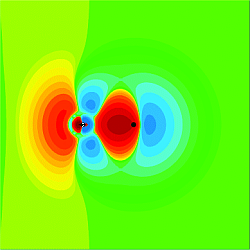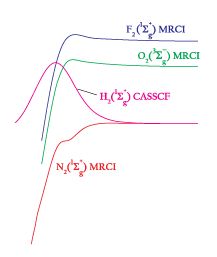James Harrison

Research
Quantum Chemistry
Advances in fundamental theory and computer technology enable us to construct wavefunctions for atoms and molecules which are of unprecedented accuracy. We use these functions to assist in the interpretation of spectroscopic experiments and to develop and refine the qualitative notions of chemical bonding. Our current focus is to understand:

The electronic structure of the ground and low-lying states of small molecules containing a transition metal atom. Diatomics of interest include MX where M is a transition metal (Sc to Zn) and X is a main group element (H to Cl). These molecules are of great interest as models for the nature of the transition meta-main group element chemical bond. Triatomics include the metal hydroxides MOH & HMO and the carbynes MCH, the understanding of which is fundamental to the reactions of transition metals with hydrocarbons. We are also interested in the structure of the mono- and dipositive ions of these systems.

The nature of molecular multipole moments and the information contained in these moments
about the chemical bond. While we all have an instinctive feeling about the meaning
of a molecular dipole moment and how it reflects the charge distribution in a molecule
the same instincts often fail when considering for example, the quadrupole moment.
Some of this problem is that the quadrupole moment is a second rank tensor while the
dipole moment is a tensor of the first rank. However even for homonuclear diatomics
where the quadrupole tensor has only one unique component the relationship between
this component and the molecular charge density is not well understood. We have recently
shown that the molecular quadrupole moment can be written as the sum of the quadrupole
moments of the constituent atoms plus a term that depends on the shift in the electron
density upon bond formation. In the course of this work we have defined the quadrupole
moment density that shows where in the molecule the molecular contribution to the
quadrupole moment comes from. We are extending these ideas to other one electron properties
like the electric field gradient at a particular nucleus and the dipole moment (still
more to learn!).
The spatial distribution of electron spin in open shell molecules. We have recently shown in the open shell nitrogen halides, NF, NCl and NBr that α and β spins flow in opposite directions as the chemical bond forms. We are exploring this observation and the role that electronegativity (chemical potential) plays.
Contact
Webpage
Area(s) of Interest
Theoretical and Computational (Th)
Chemical Physics (CP)
Physical (Ph)
Selected Publications
Electronic Structure of Diatomic Molecules Composed of a First-Row Transition Metal and Main-Group Element (H-F), J. F. Harrison, Chem. Rev. 2000, 100, 679-716.
Dipole and quadrupole moment functions of the hydrogen halides, HF, HCl, HBr, and HI: A Hirshfeld interpretation, J. F. Harrison, J. Chem. Phys. 2008, 128, 114320.
Collision-Induced dipoles and Polarizabilities of Pairs of Hydrogen Molecules: Ab Initio Calculations and Results from Spherical Tensor Analysis, X. Li, J. F. Harrison, M. Gustafsson, F. Wang, M. Abel, L. Frommhold, and K. L. C. Hunt, Proc. ICCMSE 2009.
A Hirshfeld interpretation of the charge, spin distribution, and polarity of the dipole moment of the open shell nitrogen halides: NF, NCl, and NBr, J. F. Harrison, J. Chem. Phys. 2009, 131, 044117.
“Methylene: A Personal Perspective”, James F. Harrison, pages 33-43, “Advances in the Theory of Atomic and Molecular Systems: Conceptual and Computational Advances in Quantum Chemistry” Edited by P. Piecuch, J. Maruani, G. Delgado-Barrio, and S. Wilson, Springer 2009.
Ab Initio Investigation of Titanium Hydroxide Isomers and their Cations, (H-Ti-O)+0 and (Ti-O-H)+0, Milordos E, Harrison J. F. and Hunt K. L. C, J. Chem. Phys. 2011, 135, 144111.
A Hirshfeld interpretation of the local moment composition of the quadrupole moments of the halogenated acetylenes FCCF, ClCCCl, BrCCBr, and ICCI, J. F. Harrison, Computational and Theoretical Chemistry 2012, 999, 83-88.
The ground and excited states of vanadium hydroxide isomers and their anions and cations, (V-OH)0+- and (H-V-O)0+-, Milordos E, Harrison J. F. and Hunt K. L. C., J. Chem. Phys. 2013, 138, 114305.
Hirshfeld density partitioning technique: A first application to the transition metal compounds, HScO, TiO and VO, Milordos E and Harrison J. F., J. Chem. Phys. 2013, 138, 184305-7.
CV
B.S., 1962, Drexel Institute of Technology
M.A., 1964,Princeton Univ.
Ph.D., 1966, Princeton Univ.
NSF Postdoctoral Fellow, 1966-67, Research Associate, 1967-68, Indiana Univ.
Scientist in Residence, 1980-81Argonne National Laboratory.
Awards/Honors
| Year | Award | Organization |
|---|---|---|
| 2004 | Member | (XXXVI) Midwest Theoretical Chemistry Conference (Organizing committee) |
| 2003 | President | Sigma Xi Honor Society (Michigan State University) |
| 1996 | Outstanding Faculty Award | College of Natural Science |
| 1995 | Distinguished Faculty Award | College of Natural Science |
| 1995 | Outstanding Faculty Award | College of Natural Science |
| 1992 | Member | (XXV) Midwest Theoretical Chemistry Conference (Organizing committee) |
| 1986 - 1993 | Associate Chair for undergraduate education | MSU (Chemistry) |
| 1982 | Member | (XV) Midwest Theoretical Chemistry Conference (Organizing committee) |
| 1973 - 1974 | Chairman | ACS (MSU) |
| 1972 | Organizer | (VI) Midwest Theoretical Chemistry Conference |
| 1972 - 1977 | Teacher-Scholar Award | Camille and Henry Dreyfus Foundation |
| 1972 - 1973 | Secretary | ACS (MSU) |
| 1971 - 1972 | Treasurer | ACS (MSU) |
| 1966 - 1967 | Postdoctoral Fellow | National Science Foundation |
| 1966 | Ph.D. | Princeton University |
| 1964 - 1966 | National Aeronautics & Space Administration Fellow | Princeton University |
| 1964 | M.A. | Princeton University |
| 1963 - 1964 | American Machine & Foundary Fellow | Princeton University |
| 1962 | Bachelor of Science | Drexel Institute of Technology |
| 1962 | Scholastic Achievement Award | Philadelphia ACS |
| 1957 - 1962 | Food Fair Scholarship | Drexel Institute of Technology |
| Councilor | ACS (MSU) | |
| Phi Kappa Phi | ||
| Immediate Past Chairman | ACS (MSU) | |
| Alternate Councilor | ACS (MSU) |